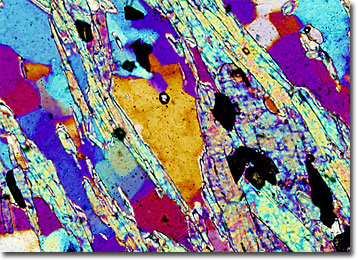Polarized Light Microscopy Digital Image Gallery
Quartz-Sericite Schist
Schist is a type of metamorphic rock that is chiefly comprised of flaky minerals and exhibits a plated structure known as schistosity. It is because of this characteristic structure that schists exhibit perfect cleavage, readily splitting along planes into thin flexible layers.

The mineralogical composition of schists is quite variable. However, some of the more common platy minerals that occur in the rock include mica, chlorite, hornblende, muscovite, biotite, and graphite. Crystals of these minerals are observable to the naked eye in samples of schist, which is one of the defining characteristics of the rock. Although not generally utilized commercially, deposits of schist may be a valuable commodity if they contain gemstones or metal ores. For instance, talc and mica schists in Upper Egypt have been mined for emeralds for thousands of years and have benefited various people and civilizations throughout history, including the ancient Greeks and the famous Egyptian queen Cleopatra.
Typically schists contain significantly lower levels of quartz than gneisses and many other rocks, but quartz-sericite schist is a variety of the rock than contains a greater amount of the mineral than normal. As its name implies, this type of schist also contains significant amounts of sericite, which is a fine-grained type of either muscovite or paragonite, both of which are relatively abundant silicate minerals. Found in various locations, one of the best known examples of quartz-sericite schist occurs in Canada, where it is a source of economically important gold deposits.
